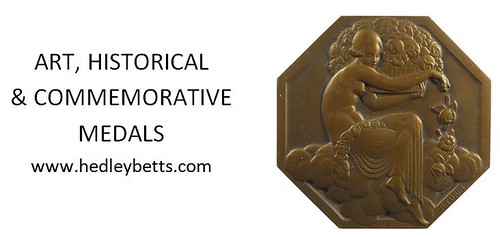
PREV ARTICLE
NEXT ARTICLE
FULL ISSUE
PREV FULL ISSUE
V25 2022 INDEX E-SYLUM ARCHIVE VOCABULARY TERM: HANDCUT, HAND ENGRAVINGHere's another entry from Dick Johnson's Encyclopedia of Coin and Medal Terminology. -Editor Handcut, Hand Engraving. Freehand cutting a metal surface or dies of any kind in the size required, by a human engraver. Hand engraving is in contrast to machine engraving, first developed in the 18th century and widely employed after 1900. Even with the development of diecutting machines, portrait lathes and various engraving machines, the need still continues for hand engraving and handcut dies. Cost and speed are two strong factors in favor of hand engraver, another is the ability to produce a die from a drawing without being required to have a three-dimensional pattern or model. Handcutting dies is the time honored way of diesinking – all dies were handcut in whole or in part prior to 1850 – the number steadily diminishing until only a small portion are handcut in the 20th century. See also ENGRAVING, How to tell Hand Engraving from Machine Engraving. Handcut versus machine engraving. In some ways it is impossible to tell for certain if a struck piece was from dies that were hand engraved or if some form of machine engraving was used in their preparation. Some general guidelines may be offered but these may not be exclusive to either type of engraving. Thus the following can serve as guidelines only: Handcut dies and pieces struck from such dies tend to have sharper lettering and detail. The devices appear well defined, the relief and lettering may have somewhat steeper sides (with steeper draft or bevel). The lettering is often produced by punches, thus similar letters may be from the same punch and be identical. The top of the lettering (from the end of the punch) may be flatter; there are sharper angles at the top and base of lettering and relief. There is a sharp juncture of the device and the background. Overall the appearance of handcut pieces is sharper, well defined images and lettering. Pieces struck from modeled and machine cut dies are generally softer in appearance; there are no sharp angles present at either the top or at the base of lettering or detail, thus effecting the softer appearance. The lettering appears more rounded. The device appears to blend into the background or field, as there is no sharp juncture at the base. There is more modulated relief in the device, and indeed, the entire struck surface is formed from one continuous modeled plane of the three-dimensional plaster model. Portraits tend to appear more lifelike. There are some technical reasons for the differences between the types of engraving. The most important of these is the shape of both the tracing point and the cutting point on the diecutting machine. If the tracing point cannot enter the crevice in the model it will not reproduce this in the die; also the bevel is limited to 15%, it cannot reproduce less than this angle of slope in the die, while a handcut die can accommodate as little as 5% bevel. The two great limitations of handcutting a die are, of course, that it has to be cut the exact size and that it is difficult to correct a cut once it has been made. This corresponds to the great advantage of the oversize model for machine diecutting which can be carved and changed repeatedly before the final stage, a model can be reduced to any size die required, and any number of dies can be made from one bas-relief model (dieshell).
To read the complete entry on the Newman Numismatic Portal, see:
Wayne Homren, Editor The Numismatic Bibliomania Society is a non-profit organization promoting numismatic literature. See our web site at coinbooks.org. To submit items for publication in The E-Sylum, write to the Editor at this address: whomren@gmail.com To subscribe go to: https://my.binhost.com/lists/listinfo/esylum All Rights Reserved. NBS Home Page Contact the NBS webmaster 
|
